Plan your Henan tour? Henan Province is situated in Central China. Henan literally means “South of the River”. Here “the River” refers to the Yellow River, the second longest river in China after Yangtze River. This province is an essential cradle of China’s civilization bestowed with long and thick Chinese history.
Henan Province often reminds us of such important places as Shaolin Temple in Dengfeng, and Longmen Grottoes in Luoyang. Well, the ancient city of Kaifeng is not to be missed if you can afford one or 2 day to explore the city. Located approx. 80 km east of Zhengzhou, Kaifeng was once the capital city of Northern Song Dynasty (960-1126) and other 6 dynasties. Today Kaifeng still keeps its old glamour though the ongoing massive city reconstruction is threatening its original appearance.
Getting to Kaifeng is relatively convenient. You may take a bus from Zhengzhou ( one and half hour ), Luoyang ( three hours). Or you may take an overnight train from Beijing West Tran Station (12 hours ), Shanghai ( seven hours).
The city of Kaifeng within the ancient city wall is compact and walkable. Like a grid pattern city of Xian and Pingyao, Kaifeng has its own axis of Zhongshan Road lined up with major attractions like Temple of the Chief Minister, Kaifeng Fu, Kaifeng Museum, Dongda Mosque, Former Site Kaifeng Synagogue, Shanshangan Guild Hall, Longting Park, Qingming Garden and City Wall.
I’ve rounded up the top 10 attractions in Kaifeng. September and October are the best time to visit Kaifeng with chrysanthemum blossoms everywhere, the city flower in Kaifeng.
1. Temple of the Chief Minister 大相国寺
Originally built in 555 AD, the temple were rebuilt for many times in Tang Dynasty, Northern Song Dynasty, Ming Dynasty and Qing Dynasty. Fires and Yellow River breaches were the main causes for the fatal damages to the temple. The present temple was renovated to a great extent in 1990s.
Temple of the Chief Minister was in its prime during Northern Song Dynasty (960-1126), the monks totaling 10,000, 64 subordinate temples and an area of 540 mu ( 35 hectares ), an imperial temple for Northern Song Dynasty.
The present temple is mainly composed of the Heavenly Kings Hall, Mahavira Hall, the Octagonal Glazed Hall, Sutra Depository Building and the Four-Faced Thousand Eye Guanyin within the Arhat Hall.
Entrance Fee: RMB 45
Opening Hour: 08:00 – 18:30
Add: 36 West Section of Ziyou Road, Gulou District, Kaifeng 鼓楼区自由路西段36号
Tel: 0378 – 5665090
How to get there
Take Bus 1,2,5,8 or walk from Kaifeng Bus or Train Station ( 2. 5km).
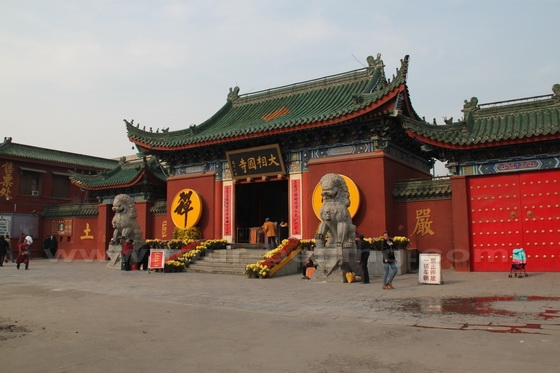
2. Shanshangan Guild Hall 山陕甘会馆
Shanshangan Guild Hall was the former lodging and meeting place for the merchants from Shanxi Province, Shaanxi Province and Gansu Province. It was first built from the ruins of Xuda Palace in 1775 during the reign of Qianlong Emperor in Qing Dynasty (1644-1911). Xuda was one of the founding fathers of Ming Dynasty ( 1368-1644). The name of the road where the present Guild is located is called Xuda Palace Road.
The past 200 years have seen Shanshaangan Hall going through numerous ups and downs. What we we see today is a small part of the orginal guild. Or more exactly it is the only remaining Guangdi Temple building inside the original guild hall. The whole temple architecture is rife with exquisite carvings out of stone, brick and wood, which vividly tell the Buddhist stories and folk tales with great artistic value.
The remaining Guangdin Temple is mainly composed of 7 parts- A huge screen wall, Opera Tower, Bell and Drum Tower, East Wing and West Wing Halls, Traditional Pailou (decorated archway), the Great Hall.
Entrance Fee: RMB 30
Opening Hour: 8:00 – 18:30
Add: Xufu Street, Kaifeng. 开封市内徐府街
How to get there
Take Bus 1,13,18 and 31 or walk from Temple of the Chief Minister
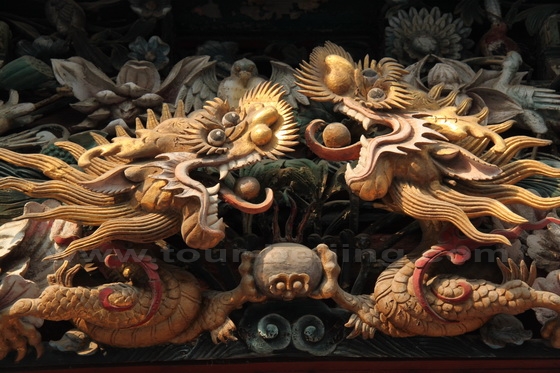
3. Kaifeng Fu 开封府
Kaifeng Fu, literally Kaifeng Government Administration Area ( popularly known as South Yamen in Chinese ) , is a tourist site reproducing the government office for the Prefecture of Kaifeng in Northern Song Dynasty ( 960 – 1126 ). Historically, Kaifeng Fu was originated in the later Liang Dynasty ( AD 907 ) with a history of over 1000 years. Kaifeng Fu went through Jin Dynasty, Yuan Dynasty, Ming Dynasty and Qing Dynasty. It was at its primary time in Southern Song Dynasty. So this replica of Kaifeng Fu is mainly built in light of the original buildings in Northern Song Dynasty.
Though Kaifeng Fu is a bit of historical kitsch, often packed with domestic tourist groups, it is still worth your experiencing Song Culture for a 40-minute short trip if you can have the time to spare. This Song Dynasty government office model takes an area of 4 hectares with 50 buildings and halls. You can visit government offices, prisons, imperial examinations, Taoism and imperial life.
Entrance Fee: RMB 60
Opening Hour: 8:00 – 18:30
Add: North Bankof Baogong Lake, Gulou District, Kaifeng 鼓楼区包公东湖北岸
How to get there
Take Bus 1,9
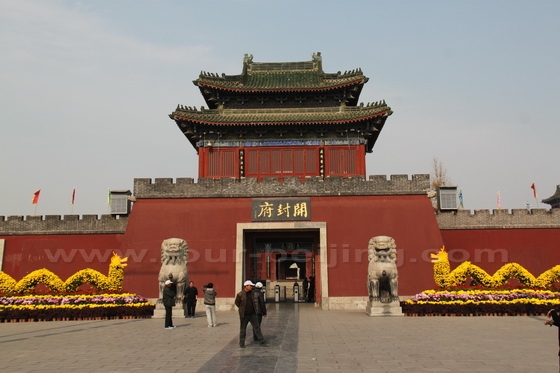
4. Iron Pagoda Park 铁塔公园
Iron Pagoda is located in the same name park – Iron Pagoda Park in the northeast corner within the ancient city wall. The Iron Pagoda was originally built in 1049 AD with over 1000 years.
It elegantly stands on the park, slender, a 55m high brick tower coated with rust-color glazed tiles, hence the name of Iron Pagoda. There is an inside narrow stairs ascending to the top for entrance fee RMB 30.
Entrance Fee: RMB 40
Opening Hour: 9:00 – 20:00
Add: 210 Beimen dajie, Kaifeng 北门大街210号
How to get there
Take Bus 1, 3, 6,20
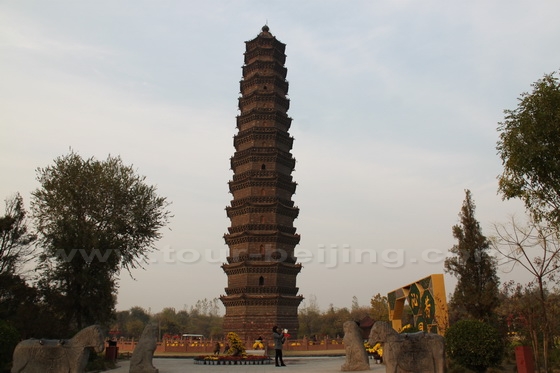
5. Kaifeng Museum 开封博物馆
Kaifeng Museum is located by the south bank of Baogong Lake. Kaifeng Museum is housed in a magnificent Chinese traditional building with yellow glazed covers.
It has an display area of over 5000 square meters with 13 halls. It has a collection of over 50,000 artifacts and 50,000 professional books. Notably, you will see archaeological finds, woodblock prints and more.
Entrance Fee: Free ( closed on Monday )
Opening Hour: 9:00 – 17:00
Add: 26 Yingbin Road,Kaifeng
How to get there
Take Bus 1
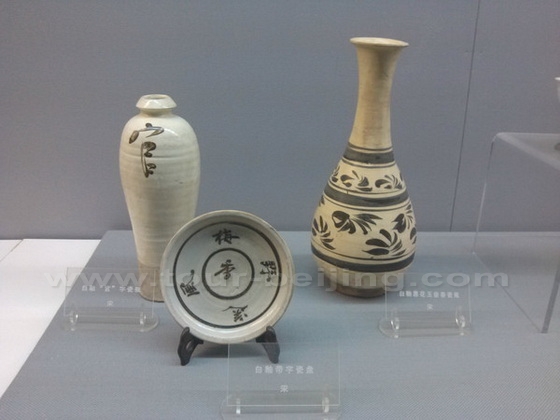
6. Longting Park 龙亭公园
Dragon Pavilion is the main structure in the park for the same name sake with an area of 83.13 acres half covered by two lakes – East Dad Lake (Pan Family Lake) ans West Good Lake (Yang Family Lake). Dragon Pavilion is actually not a pavilion, but a palace built on the 13m-high blue brick terrace.
A flight of 72-steps leads up to the platform of the terrace with stone balusters on both sides. In the middle of the flight of steps are cloud-dragons. The Palace Hall atop the terrace is a wooden structure with double-gable roofs. The terrace is fenced with stone balusters. People have a good view of the surrounding scenery – the downtown, Qing-Ming Street and the two lakes. The terrace is aperfect place to view the sunset with beautiful glows.
The building of the Dragon Pavilion dates back to to 1692, the 31th year during the reign of Kangxi Emperior in Qing Dynasty ( 1644-1911). Originally known as Wanshou Pavilion, it was built on the coal hill of the former palace buildings of King Zhou in Ming Dynasty (1638-1644). It housed the emperor tablets for the local officials to pray. Later the Coal Hill wad renamed Dragon Pavilion Hill, hence the name for Dragon Pavilion.
Kaifeng is the ancient capital city for 8 dynasties with their palaces successively built on the location of the present Dragon Pavilion and the two lakes. The first man who chose this place with fengshui that prospered for 0ver next 1200 years was Li Mian, the local governor in Tang Dynasty who had moved his office building from Shanqiu to the present Kaifeng in the year of 781 , thus starting the axis of the ancient Kaifeng for over 1200 years.
Entrance Fee: Free ( closed on Monday )
Opening Hour: 9:00 – 17:00
Add: at the northern end of Zhongshan Road, Gulou District, Kaifeng 河南省开封市鼓楼区中山路北段
How to get there
Take Bus 1,15
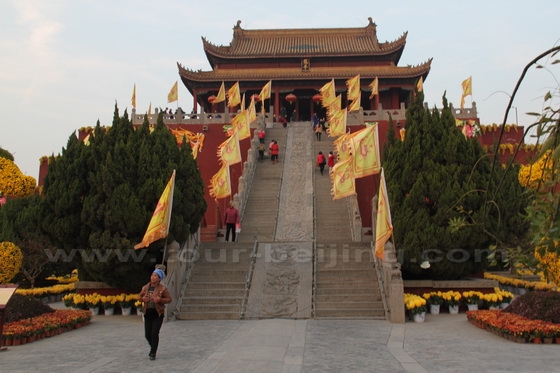
7. City Wall 开封古城墙
The present Kaifeng City Wall is almost the same length of Xian City Wall, 14,4 km long. Its original building goes back to 365 BC when Weihui King during Warring States Period moved his capital here and built a city wall known as Dalingcheng City Wall with a history of over 2300 years.
In 960, Kaifeng was dedicated as capital of Northern Song Dynasty which lasted 168 years with 9 emperors. The 168 years found the city wall in Kaifeng developed into Outer Wall, Inner Wall and Imperial Wall, massive and magnificent. The present city wall was the remains of the city wall renovated in Qing Dynasty featuring the building style of Ming and Qing dynasties.
Entrance Fee: Free
Opening Hour: all day
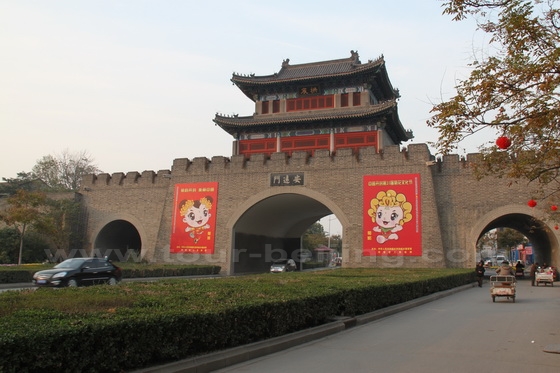
8. Kaifeng Synagogue 开封犹太教堂
Almost nothing remains of Kaifeng Synagogue. The former synagogue site is located at Nanjiaojing Hutong on the east side of north section of Beitu Street, Kaifeng 南教经胡同(开封北土街北段东侧). The synagogue was originally built in 1163 at the end of Northern Song by the Jewish Neighborhood in Kaifeng who had come to Kaifeng in Northern Song Dynasty for trade. At their prime time in Ming Dynasty, there were over 3000 Jew residents in Kaifeng.
The synagogue was rebuilt in 1279 (Yuan Dynasty) and 1461 ( Ming Dynasty). Li Zicheng ( 1606–1645), a Chinese rebel leader who overthrew the Ming Dynasty, led his army attacking Kaifeng. In 1642, his army made the breaches of the Yellow River dykes by both sides and had Kaifeng heavily flooded and thus ended the siege of Kaifeng and killed over 300,000 residents in Kaifeng, destroying the Jewish neighborhood of Jewish people. Again in 1841, the synagogue was turned to be used to protect the city Kaifeng threatened by the the breaches of the Yellow River dykes. With the last chief Rabbi passed away in 1905, the synagogue gradually disappeared from the world stage.
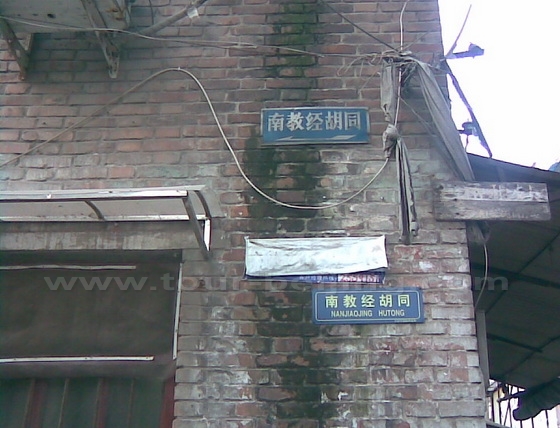
9. Tiancheng Woodblock New Year Painting Old Shop at Zhuxian Town 朱仙镇天成老店
An ancient town known as Zhuxian Town 23km south of Kaifeng. Zhuxian Town is notable for its over 1000 year-old craft of woodblock new year paintings.
Traditionally, when Chinese lunar new year ( Spring Festival ) comes, families would paste new year paintings on their door frames and houses with the prints of new year pictures. New year paintings represent a good luck and fortune to say goodbye to the past year and welcome the new year. New year pictures are kinda of unique Chinese traditional folk culture.
Today many people would buy the prints of mass-produced new year paintings from the factories. But still many people and collectors prefer to buy hand-made new year paintings. The Zhuxian Town woodblock new year paintings are one of the most famous man-made new year paintings in China.
The woodblock new year paintings in Zhuxuan Town is an untangible cultural heritage in China. It has been on the verge of extinction due to the new printing technology. Recently the governments at all levels have allocated funds to support and develop the craft of man-made new year paintings.
10. Xisi Night Market 西司夜市
Xisi Night Market is one of the two night markets on Kaifeng with the other being Gulou Night Market. Xisi Night Market is at near No.88, Dingjiao Road, Kaifeng. You will be bombarded with all kinds of snacks, local and from other provinces.
You may have a bite of Muslim kebabs, cold noodles, peanut cakes and sip almond tea, and the list could be much longer.
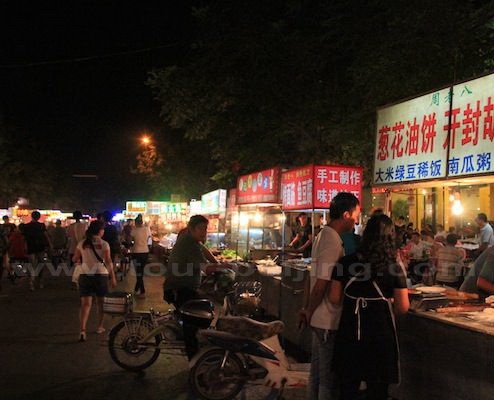
Any questions, just drop a line.






Hello ! Is somewhere in china a temple like Dragon Pavilion witch should have at the entry 2 lions like those ones at Kaifeng Fu entry.
As i was a kid i had a dream, over and over again, for years, how i did fight with a person in black dress with a sword in his hand and his face was always covered. I did always lost this fight but i woke up 🙂 The problem is just, as kid i called myself xing xang song or something like that. I’m 40 years now and still want to find out if this place i had in my dream exists. So, please, if you can help me to give me some names or pictures to similar places i would apreciate that. I do not know China . Thanks, greetings from Hungary.
Hi Gab,
Happy Holidays!
It is intersting to hear your childhood story. YOu check out the link below for more information:
https://en.wikipedia.org/wiki/Chinese_guardian_lions
Forbidden City in Beijing has beautiful lions at the entrance.
Wish your dream comes true!
Thank you Daniel.
I doesn’t look like that i had in my dreams coz the stairs arent’t that high but i fond something else even if i do miss the lions in that image but the place looks almost similar. The lions you did show me are very similar to what i have seen. The pictures i fond on the internet aren’t similar with that you can dream anyway. There is still that question whitch i can’t answer. Why did i dream about china and some Guardians of God or Four Guardians of the Four Compass Directions when i had no contact with any china civilisation as i was 7-8 years old. We did not learn anything about China as i was young. We had no internet and no pictures coz i’m birt in Romania in Ceausescu time.
Thank you for the answer and wish you and your team , happy new year 2017
Hi Gab.
A lot of chinese temples with traditional architectures have that kind of descriptions you saw in your dreams as a kid. You may have unconsciously got it from school lessons like social studies or history or saw it on TV. This may shed light to what you said about 4 guardians or so https://en.m.wikipedia.org/wiki/Four_Heavenly_Kings
Best regards.